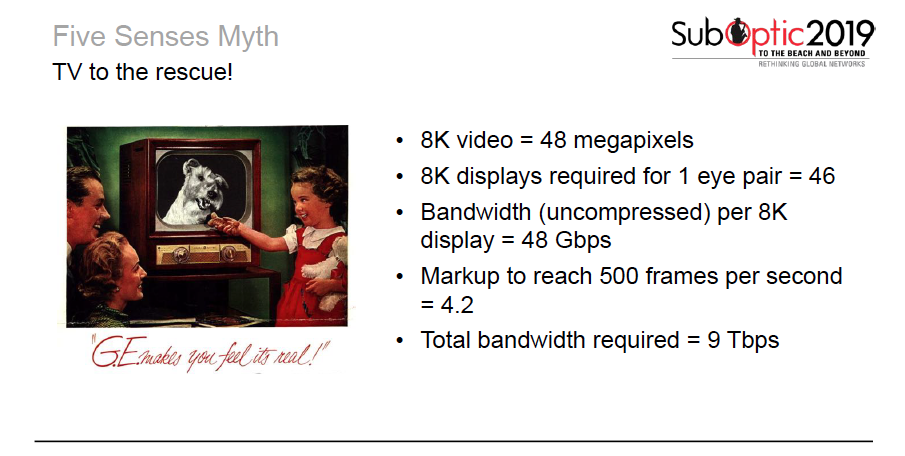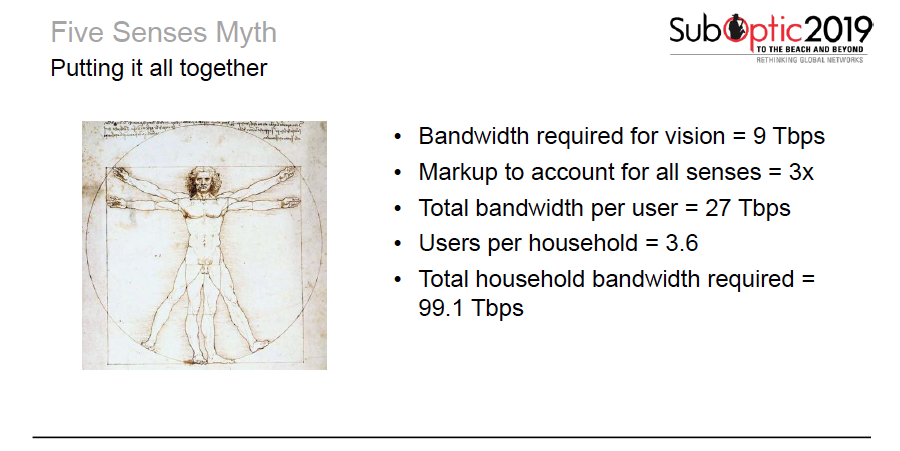Our thirst for bandwidth must have a ceiling. It just must.
In our first-ever user-submitted myth, Chief Engineer of the Australia-Japan Cable Phil Murphy asked our experts a tough one. If it were possible to create the ultimate VR device that delivered a fully-immersive experience—catering to all possible sensory inputs—what would the bandwidth be and would our own senses create a cap?
In short: will sensory overload dictate an eventual bandwidth ceiling?
How Do We Even Test This?
I started by exploring the sense we understand the most: our vision.
Here’s a fun little experiment you can try at home, provided you have a guinea pig with a detached retina. Take the retina and place it on a multi-electrode array. Show the retina video images and measure how frequently the nerve endings fire signals. That’s what researchers from the University of Pennsylvania did 10 years ago. If you take their results and upscale it to the slightly-more-complex human eye, turns out it’s about 8.6 Mbps per eye. That’s astonishingly low!
Unfortunately that result is a red herring. Our thought experiment doesn’t imagine a dystopian future where we beam images forcibly into viewers’ brains. Rather, we’re trying to recreate a panorama of natural-looking images for users, permitting them to focus wherever they want.
So let’s back up a bit. It turns out that our field of vision for one eye is about 135° horizontal and 135° vertical. Humans can perceive about 200 pixels per degree; this means that in our panorama, we can perceive about 1,500 megapixels per eye pair.
TV Time
Great, but how do we recreate moving images? Turns out there is a century-old, beloved invention that we use: television. A single 8K TV display can show about 33 megapixels.

Applying this to our 1,500 megapixels per eye pair math, it means that we need 46 8K displays for a panorama. And the capacity needed to supply that? My model lands on 48 Gbps per display for an uncompressed signal. I also considered frame rate, calculating 500 frames per second and then applying a 4.2 multiplier to make this VR experience as true to what our human eyes can perceive as absolutely possible.
Plug all this into our calculator and we’re looking at 9.1 Tbps per person for simply the visual component of this immersive virtual experience.
Estimating All Other Senses
Vision isn’t the only sense we must account for; but we can use vision as a base to mark up all the other senses. This will allow us to broadly estimate the bandwidth that this magic VR experience will require.
I used a 3X markup in his model, putting us at 27.3 Tbps per user. With an average of 3.6 users per household, that’s 99.1 Tbps per household.

On average, the internet connects our homes 26 Mbps. To reach 99.1 Tbps we need to find a way to increase the capacity to individual households by a factor of 3.8 million.
Here’s where the magic of compounded growth comes into play. If we can increase our capacity by 40% a year—which is not outside the realm of possibility—how long would it take to get us to that factor of 3.8 million?
Just 25 years.
Yup. A reasonable increase of 40% a year in capacity would give us the ability to accommodate this hypothetical all-bandwidth-all-the-time VR device.
Could that mean that 2044 is the year when bandwidth growth ceases? Well, our estimates don’t consider whether machine-to-machine traffic will accelerate...or if bionic devices will augment our senses.
But, sure! Why not?! ¯\(ツ)/¯
The Verdict
Is there a theoretical maximum amount of bandwidth that any one person could consume, if given technology that maximized all sensory inputs 24/7?
This is pretty fanciful, but let’s say we can confirm this one.
Postscript
If, like me, you ever worry about money, you may wonder how much this would cost. Let’s look at submarine cables exclusively. The replacement cost for all of today’s undersea fiber-optic networks is $25 billion. If you upscale that number by the required 3.8x million factor needed to reach our maximum VR future, you get this CAPEX requirement: $95,607,382,804,334,700.
That’s 96 quadrillion dollars.
So, good news/bad news. If you’re in the subsea business, the good news is that you’ll only need to win just one percent market share of this new business and you’ll be a quadrillionaire! The bad news is that the combined world GDP is only $88 trillion. Unless the subsea cable cost per bit falls, we’ll need to set aside every single dollar on earth for one millennium before we can save up enough to build our network.
That may seem a steep price to pay, but just think how cool our intercontinental VR chats will be.
Tim Stronge
Tim Stronge is Chief Research Officer at TeleGeography. His responsibilities span across many of our research practices including network infrastructure, bandwidth demand modeling, cross-border traffic flows, and telecom services pricing.





